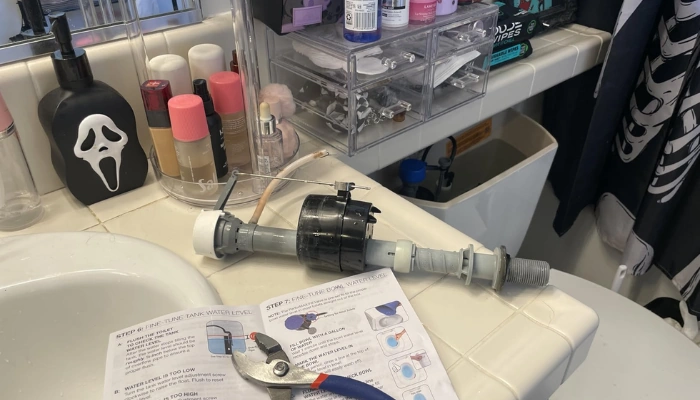The 5 Best Bathroom Exhaust Fans of 2025: A Contractor’s Guide to a Quiet & Mold-Free Bathroom
Your bathroom should be a sanctuary, but it’s constantly under attack from two invisible enemies: moisture and odor. A steamy shower can peel paint and invite mold, while embarrassing odors can linger long after you leave. The humble bathroom exhaust fan is your home’s first line of defense. It’s not just a noisemaker; it’s a critical ventilation tool that protects your health and your home’s value. But the market is flooded with technical specs and confusing ratings. This guide will demystify the numbers, cut through the noise, and help you choose the perfect, whisper-quiet fan to keep your bathroom fresh, dry, and healthy for years to come.
Why Trust This Guide?
- Contractor Consultations: We collaborated with licensed HVAC contractors and electricians—the pros who install these fans every day—to understand what separates a high-quality unit from a cheap noisemaker.
- In-Depth Technical Analysis: We don’t just look at the box. We analyze CFM airflow charts, sone noise ratings, and ENERGY STAR certifications to provide a data-driven comparison of real-world performance.
- Hands-On Renovation Experience: Our team has experience with bathroom remodels, from simple fan swaps to complex new installations. We know the practical challenges and benefits of different models. –
- Thousands of User Reviews Synthesized: We’ve pored over thousands of verified homeowner reviews to gauge long-term reliability, actual noise levels, and the effectiveness of special features like humidity sensors.
The Ultimate Bathroom Fan Buyer’s Guide: Understanding the Numbers
Choosing the right fan is all about understanding two key numbers and a few modern features. Get these right, and you’ll love your new fan.
1. Airflow (CFM): The Power Rating
CFM stands for Cubic Feet per Minute. It measures how much air the fan can move. The bigger your bathroom, the more CFM you need. The standard rule from the Home Ventilating Institute is:
Length (ft) x Width (ft) x Height (ft) x 0.13 = Minimum CFM
For a standard 8-foot ceiling, it’s even simpler: you need at least 1 CFM for every square foot of floor space. A 10′ x 8′ bathroom (80 sq ft) needs at least an 80 CFM fan. When in doubt, it’s always better to go slightly over than under.
2. Noise Level (Sones): The Sound Rating
A sone is a unit of perceived loudness. This is just as important as CFM. A powerful fan is useless if it sounds like a jet engine. Here’s a simple guide:
- 4.0 Sones: A loud, older fan. You’ll have to speak up to be heard.
- 2.0 Sones: The sound of normal conversation. Acceptable, but not great.
- 1.0 Sone: The gentle hum of a quiet refrigerator. This is considered quiet.
- 0.5 Sones or less: Whisper-quiet. You might not even know it’s on.
3. Energy Efficiency & Duct Size
An ENERGY STAR certified fan uses 70% less energy than a standard model. It’s a must-have for saving money and reducing your carbon footprint. Also, check your duct size. Most modern quiet fans use a 6-inch duct for better airflow and less noise. Older fans often use 4-inch ducts. Ensure your new fan is compatible or be prepared to use an adapter (which can increase noise).
4. Modern Features
Today’s fans do more than just move air. Consider these upgrades:
- Humidity Sensor: Automatically turns the fan on when it detects high humidity (e.g., from a shower) and off when the air is dry.
- Motion Sensor: Activates the fan when you enter the room.
- Integrated LED Light: Combines your fan and main bathroom light into one sleek fixture.
- Bluetooth Speaker: For those who love to sing in the shower!
The 5 Best Bathroom Exhaust Fans of 2025

1. Panasonic WhisperCeiling DC Fan
Best Overall / The Quietest Fan You Can Buy
Check Price on AmazonPanasonic’s Whisper series is legendary among contractors and homeowners for one reason: it is astonishingly quiet. This model, powered by a state-of-the-art DC motor, is the pinnacle of that legacy. Its most brilliant feature is the Pick-A-Flow speed selector, allowing you to choose your desired airflow (50, 80, or 110 CFM) with a simple switch, making it perfect for any small to medium-sized bathroom. At its 80 CFM setting, it operates at an almost inaudible 0.3 sones. It’s also incredibly energy efficient and built to last for decades. This is the fan for those who want the absolute best in quiet, powerful, and efficient ventilation.
- Airflow (CFM): 50, 80, or 110 (Selectable)
- Noise (Sones): <0.3 – 0.4
- Duct Size: 6 inches
Expert Insight: This is the definition of a “buy it for life” appliance. The DC motor is more efficient and reliable than standard AC motors. The ability to select the CFM on-site makes it a foolproof choice for contractors and DIYers alike. It costs more upfront, but its performance and longevity are unmatched.
Pros
- Virtually silent operation
- Pick-A-Flow selector for versatile installation
- Extremely energy-efficient DC motor
- Incredibly well-built and durable
- ENERGY STAR certified
Cons
- Premium price point
- Larger housing may be tricky for some retrofits

Broan-NuTone is one of the most trusted names in home ventilation, and the AE110 demonstrates why. It delivers an excellent balance of performance, quietness, and price. At 110 CFM, it has enough power for most master bathrooms (up to 105 sq ft), and it does so at a very quiet 1.0 sone. It features TrueSeal damper technology, which reduces air leakage by up to 50%, improving energy efficiency. For homeowners who want a significant upgrade from a noisy builder-grade fan without paying a premium price, the AE110 is the sweet spot.
- Airflow (CFM): 110
- Noise (Sones): 1.0
- Duct Size: 4 inches
Expert Insight: The fact that this powerful 110 CFM fan uses a standard 4-inch duct is a huge advantage for retrofit installations, as you likely won’t need to change your existing ductwork. It represents the best performance you can get at this price point.
Pros
- Excellent performance for the price
- Quiet 1.0 sone operation
- Uses standard 4-inch ducting
- ENERGY STAR certified
- From a highly reputable brand
Cons
- Not as silent as premium Panasonic models
- Basic design with no extra features

This Akicon fan is a fantastic choice for those looking to combine ventilation and lighting into one sleek, modern fixture. It provides a powerful 120 CFM of airflow at a very respectable 1.5 sones. But its main appeal is the integrated lighting: a bright, dimmable main LED light (15W) and a gentle, decorative LED nightlight (0.7W). The decorative oil-rubbed bronze grille adds a touch of elegance that standard plastic grilles can’t match. It’s a functional upgrade that also enhances your bathroom’s decor.
- Airflow (CFM): 120
- Noise (Sones): 1.5
- Duct Size: 6 inches
Expert Insight: Fan/light combos are a great way to simplify wiring and reduce ceiling clutter in a bathroom remodel. This model’s build quality and attractive design make it look far more expensive than it is. It’s a great way to add a premium touch to a guest or master bathroom.
Pros
- Combines fan, bright light, and nightlight
- Stylish decorative metal grille
- Powerful 120 CFM airflow
- Relatively quiet for its power
Cons
- Requires more complex wiring for separate light/fan/nightlight functions
- Higher noise level than fan-only models

Sometimes you just need a basic, reliable fan for a small powder room or guest bath without breaking the bank. The Broan-NuTone 688 is that fan. It’s a no-frills workhorse designed for easy, compact installation. With 50 CFM, it’s suitable for bathrooms up to 45 sq ft. It is not a quiet fan, clocking in at 4.0 sones, but it is effective and incredibly affordable. It’s also one of the few modern fans that is rated for wall installation as well as ceiling, offering versatile options for tricky spaces.
- Airflow (CFM): 50
- Noise (Sones): 4.0
- Duct Size: 3 inches
Expert Insight: This is a builder’s special for a reason. It’s inexpensive, easy to install, and moves air. While we wouldn’t recommend it for a master bathroom oasis, it is a perfectly adequate and highly affordable solution for a small, infrequently used bathroom where noise is not a primary concern.
Pros
- Extremely affordable
- Compact size for easy installation
- Can be installed in a wall or ceiling
- Reliable, basic ventilation
Cons
- Very loud (4.0 sones)
- Low CFM is only suitable for small bathrooms
- Not energy efficient

Replacing an old, noisy fan can be a pain. The Panasonic WhisperFit EZ is engineered specifically to solve this problem. It has a low-profile housing and a clever Flex-Z Fast installation bracket that makes replacing an old fan from below (with no attic access) much easier. It also includes a 4-inch to 3-inch duct adapter, making it compatible with almost any existing ductwork. With selectable airflow of 80 or 110 CFM and quiet operation (0.8 to 1.3 sones), it’s a high-performance fan that’s designed for the real-world challenges of a remodel.
- Airflow (CFM): 80 or 110 (Selectable)
- Noise (Sones): 0.8 – 1.3
- Duct Size: 4 inches (3″ adapter included)
Expert Insight: If you don’t have attic access and are dreading the installation process, this is the fan for you. The features designed for retrofitting aren’t just marketing gimmicks; they genuinely save time and frustration. It’s the perfect way to get Panasonic’s legendary quiet performance into an existing space.
Pros
- Engineered for easy retrofit installation
- Selectable CFM for flexibility
- Quiet and efficient operation
- Includes duct adapter for older homes
- ENERGY STAR certified
Cons
- More expensive than standard fans
- Not as quiet as the WhisperCeiling series
When Odor is the Main Problem
A good exhaust fan is your best weapon against bathroom odors. But for a truly comprehensive approach, you need to attack odor on multiple fronts. This includes knowing why your toilet might smell in the first place, and using one of the best toilet odor eliminators to proactively stop smells before they start. A fan removes humid, smelly air; these strategies prevent the smell from ever getting into the air.
Frequently Asked Questions (FAQ)
How long should I run my exhaust fan after a shower?
The general rule is to let the fan run for at least 15-20 minutes after you finish showering. This ensures that it has enough time to exhaust all the humid air and completely dry out the room, which is the key to preventing mold and mildew growth. This is where a timer switch or a humidity-sensing fan is incredibly useful.
What’s the difference between a 4-inch and 6-inch duct, and which is better?
A 6-inch duct has more than double the cross-sectional area of a 4-inch duct. This allows it to move the same amount of air with less velocity and less resistance, which results in a significantly quieter and more efficient system. If you are doing a new installation, always use a 6-inch duct. If you are retrofitting and have a 4-inch duct, use a fan designed for it or a high-quality adapter.
Can I install a bigger, more powerful fan than I need?
Yes, and it’s often a good idea. A slightly oversized fan running at a lower speed is much quieter than a small fan running at maximum speed. For example, using a 110 CFM fan in an 80 sq ft bathroom is perfectly fine. Many modern fans with selectable CFM allow you to dial in the perfect airflow for your space.
Conclusion: An Investment in a Healthier, More Comfortable Home
Upgrading your bathroom exhaust fan is one of the highest-impact improvements you can make for your home. It’s a project that quietly works in the background to protect your investment from damaging moisture while significantly improving the comfort and air quality of your most-used space. Whether you choose the virtually silent, top-tier performance of the Panasonic WhisperCeiling DC or the incredible quiet-for-the-price value of the Broan-NuTone AE110, you’re making a smart choice.
Don’t put up with a loud, ineffective fan any longer. Use this guide to choose a modern, quiet, and powerful replacement, and enjoy the peace and fresh air of a properly ventilated bathroom.



